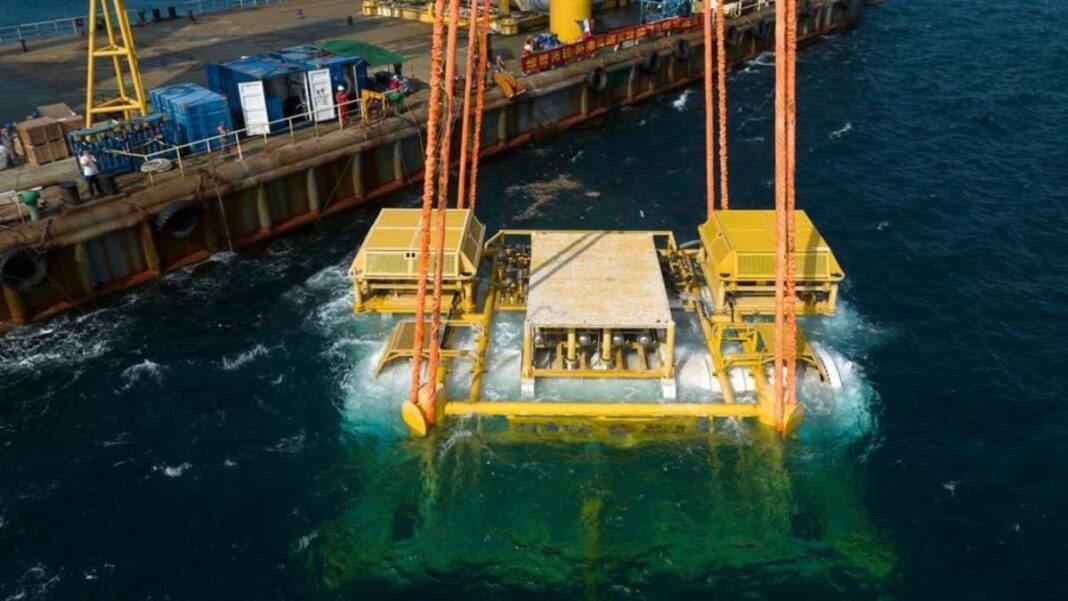China’s Highlander has launched an underwater data center in Hainan, the first project like it to be deployed at commercial scale. The energy demands of Ai data centers come largely from the cooling requirements of the servers, and China has answered this question by placing their Ai data centers underwater. This is something that’s been successfully experimented with by Microsoft among others but hasn’t been deployed commercially before now. The benefits of submerged data centers include a reduction of 90% in cooling costs as the ocean’s currents do what fresh water would otherwise; this translates into 40% more compute than a comparable land-based system. When coupled with renewable energy the costs drop further as this project is largely powered by an adjacent offshore windfarm; the company says that it’s 95% powered with renewable energy.
A drone photo taken on Feb. 18, 2025 shows Hainan’s commercial underwater intelligent computing cluster being lowered into the sea near Lingshui Li Autonomous County in south China’s Hainan Province. The project is now finished and commercially operational.
Xinhua
Ai and Water
Microsoft and others have built underwater data centers, but no projects of this caliber are currently operating in the West. Anything that saves water is welcome as current land-based data centers are often built in arid regions and require massive water withdrawals that stress already water stressed regions. The current trajectory is toward continued water disregard, as the recent batch of data centers announced by OpenAI will be built in Texas, New Mexico, and somewhere in the Midwest. These states are not water abundant, and any withdrawals will come at the expense of local residents’ drinking water and competing industries such as agriculture.
The current levels of water stress across America. The scale goes from “none” to “exceptional drought.” Most of the country shows some level of water scarcity.
U.S. Drought Monitor
More encouraging from Sam Altman this month is the news that Samsung and OpenAI will develop floating data centers, a signal of openness and sign that OpenAI recognizes the strengths of diversification. The specific reasons stated in Samsung’s statement about this collaboration highlight a few strategic advantages of floating data centers, “Floating data centers are considered to have advantages over data centers because they can address land scarcity, lower cooling costs and reduce carbon emissions.”
What’s Amazon’s response to this? They plan to build Ai data centers in space. They’ll save water for cooling because it’s cold in space, and with large solar arrays they’ll have a limitless power source. The EU supports the idea and other companies are working on the this; one company has already tested a launch and claim success; with some advancements in rocketry and solar arrays, some claim this could be viable by 2037. Whenever this feat is achieved and normalized, it will drop the water demands of Ai to zero while allowing infinite expansion of capacity while removing land competition on earth. Ambitious plan; I would encourage that we continue with sea based instead, but at least space-based is more viable in the long term than land-based solutions that will run out of both water and land.
McKinsey’s forecast for data center growth shows steady expansion. Land and water are finite.
McKinsey and Company
Water Difficulties in Britain
Do we need to worry about water availability and data centers? Do we have a general need to conserve water? Choosing Britain, an economically developed nation as our example: yes. The water usage of Scottish data centers has quadrupled since 2021. The United Kingdom famously has problems with water infrastructure and drought, and their largest water utility, Thames Water, is dealing with headlines like this one from earlier this month: “Why is Thames Water in so much trouble?”
In short, Thatcher.
Problems aren’t limited to this single utility as Mark Thurston, the CEO of Anglian Water, was intercepted by activists this week attempting to place him under citizen’s arrest for “public nuisance.”
As Navaro Media explains, this direct action comes days after Anglian Water’s approval to raise the cap on water bills to fund infrastructure while the company posts profits. This comes the same year that the UK approves up to two years in prison for water company bosses that impede investigations into sewage spills. How normalized must greed and obstruction by British water executives have been? Bad enough to require legislation on the matter and 158 million pounds in fines paid by the water utilities for failings related to water and sewage leaks, as reported by the Financial Times.
What can be done to repair the bursting pipes and leaking sewage, and lower the annual water bill that’s now up 30% for some since April? Surely not to use over 13 million liters of water a year to cool Ai data centers in Scotland. The European Union plans to triple its data center capacity over the next five to seven years as they try to stay relevant in the global Ai race and given that 34% of Europe’s population lives in areas with seasonal water scarcity, we can see why the submerged and floating designs should instead be explored.
The UK isn’t doing well with water security or efficiency generally; nor are Spain or Greece, where expansive data center buildouts are underway. To build data centers without answering the water security question is governmental negligence.

